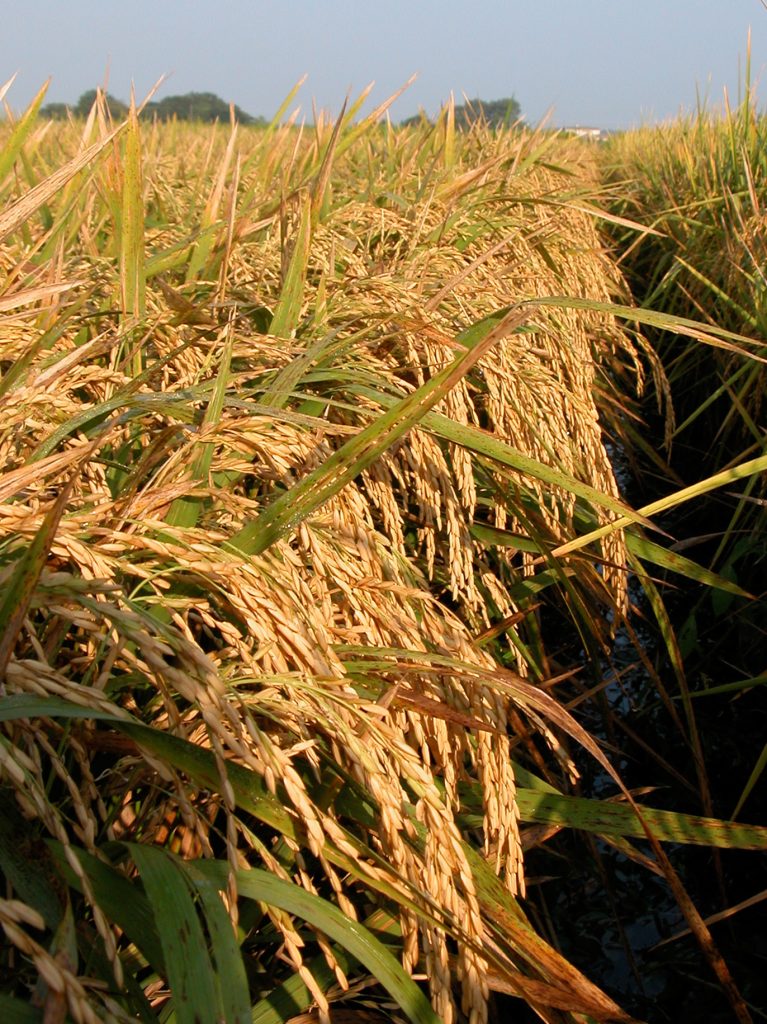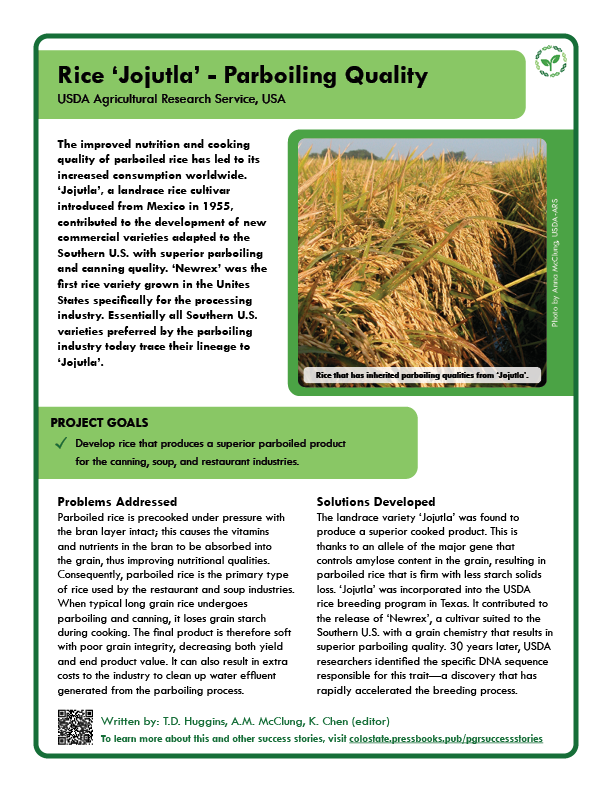Cereals and Pseudocereals
Rice ‘Jojutla’ – Parboiling Quality
U.S. RICE CULTIVARS WITH SUPERIOR PARBOILING QUALITY TRACE TO A VARIETY FROM MEXICO
Trevis D. Huggins and Anna M. McClung
USDA-ARS Dale Bumpers National Rice Research Center, 2890 Highway 130 E, Stuttgart, Arkansas 72160.
Corresponding author: trevis.huggins@usda.gov
OUTLINE
1. SUMMARY

The ‘Jojutla’ rice cultivar, introduced from Mexico in 1955, contributed to the development of new varieties adapted to the Southern Unites States with superior parboiling and canning quality. ‘Newrex’ was the first rice variety grown in the U.S. specifically for the processing industry. Essentially all Southern U.S. varieties preferred by the parboiling industry today trace their lineage to ‘Jojutla’.
The goal was to develop rice that produces a superior parboiled product for the canning, soup, and restaurant industries.
Download a printable fact sheet by clicking the image below.
2. PROBLEMS ADDRESSED
Parboiled rice (Oryza sativa L.) is precooked under pressure with the bran layer intact; this causes the vitamins and nutrients in the outer bran layer to be absorbed into the interior of the grain, thus making the final milled product more naturally nutritious. Consequently, parboiled rice is the primary type of rice used by the restaurant and soup industries.
When typical long grain rice undergoes parboiling and canning processes, it loses grain starch during cooking. The final product is therefore soft with poor grain integrity, decreasing both the rice yield and end product value. It can also result in extra costs to the industry to clean up water effluent generated from the rice parboiling process.
3. SOLUTIONS DEVELOPED

‘Jojutla’, a landrace variety grown in Mexico during the 1950s, was found to produce a superior cooked product. This is thanks to an allele of the major gene that controls amylose content in the grain, resulting in parboiled rice that is firm with less starch solids loss. This variety was incorporated into the USDA Agricultural Research Service rice breeding program in Texas.
After 11 years of breeding, processing evaluations, and selections, the cultivar ‘Newrex’ was released. It combined the agronomic traits suitable for production in the Southern USA with the grain chemistry characteristics that resulted in superior parboiling quality.
Some 30 years later, USDA researchers identified the specific DNA sequence that results in the high amylose content and the strong starch viscosity that is the basis for the superior processing quality. This DNA sequence information can now enable rapid selection for this processing trait, thus accelerating the breeding process.
Collaborators involved in developing solution:
- Charles N. Bollich and Bill D. Webb, USDA-Agricultural Research Service, Beaumont, Texas
4. IMPACT
The improved nutrition and digestibility of parboiled rice has led to its increased consumption worldwide (Muchlisyiyah, et al. 2023). Parboiling quality is therefore an essential feature for a significant portion of rice production. Essentially all Southern U.S. varieties that are preferred by the parboiling industry can trace their lineage to ‘Jojutla’.
5. GERMPLASM
‘Jojutla’ (PI 230104-1) is a landrace rice variety that was collected in Sonora, Mexico in 1955 and brought to the United States. Historical information for this accession can be found at GRIN-Global: Clor 12467. Several ‘Jojutla’ selections are maintained by the National Plant Germplasm System (NPGS) and are available for researchers and breeders through GRIN-Global.
‘Newrex’ was developed by USDA staff in Texas and is still maintained by the NPGS. More information is available from GRIN-Global: Clor 9969. ‘Newrex’ was registered in the Crop Science Journal and given the registration number of 54 (Bollich et al., 1980).
6. REFERENCES
Bollich CN, Webb BD, Marchetti MA, Scott JE. 1980. Registration of Newrex rice. Crop Science 20:286. https://doi.org/10.2135/cropsci1980.0011183X002000020048x
Muchlisyiyah J, Shamsudin R, Kadir Basha R, Shukri R, How S, Niranjan K, Onwude D. 2023. Parboiled Rice Processing Method, Rice Quality, Health Benefits, Environment, and Future Perspectives: A Review. Agriculture 13:1390. https://doi.org/10.3390/agriculture13071390
7. CHAPTER INFORMATION
Citation: Huggins TD, McClung AM. 2024. Rice ‘Jojutla’ – Parboiling Quality. In: Volk GM, Chen K, Byrne P (Eds.) Plant Genetic Resources: Success Stories. Fort Collins, Colorado: Colorado State University. Date accessed. Available from https://colostate.pressbooks.pub/pgrsuccessstories/chapter/rice-jojutla-parboiling-quality/
Content originally submitted: March 6, 2024
Date of publication: August 13, 2024
USDA is an equal opportunity provider, employer, and lender. Mention of trade names or commercial products in this article is solely for the purpose of providing specific information and does not imply recommendation or endorsement by the U.S. Department of Agriculture.


